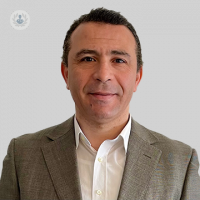Preventing the development of peripheral vascular disease
Written by:Peripheral vascular disease affects the flow of blood through the body’s arteries and can, if left untreated, have serious consequences. Being aware of the risk factors and maintaining a healthy lifestyle, however, can prevent the condition from developing. In this article, the second of a series on peripheral vascular disease, highly esteemed consultant vascular and endovascular surgeon Mr Mohamed Abdelhamid expertly outlines who is at high risk of the condition and what steps people can take to reduce the likelihood of serious complications.

Who is at high risk of developing peripheral vascular disease?
There are a number of factors which make a person more likely to develop peripheral vascular disease, or a blocking of the arteries. These factors include:
- smoking
- high cholesterol
- high blood pressure
- diabetes mellitus
- being male
- increasing age
The more risk factors present in one person, the higher the risk they will develop narrowing of the blood vessels, also known as atherosclerosis, that can cause peripheral arterial disease. The presence of narrowed or blocked arteries can affect the whole arterial tree and that includes blood vessels to the heart, brain and legs.
It is not uncommon to find patients who have more than one vascular bed affected including patients with peripheral arterial disease, coronary artery disease (heart disease) and cerebrovascular disease (stroke or mini stroke).
Patients who have diabetes and patients who have chronic kidney disease (renal failure) are at higher risk of developing peripheral arterial disease due to narrowing and hardening of the small blood vessels in the legs.
What lifestyle changes can people make to try to stop the condition becoming more serious?
Although, the atherosclerosis in the arteries will persist, there are steps and life style changes that people can make to improve the symptoms.
Stopping smoking is crucial and of ultimate importance and is in fact the single most important thing a patient with peripheral vascular disease can do to make a positive impact. Smoking causes the arteries to become narrowed which prevents the normal blood flow through the arteries. Smoking also makes the blood stickier than normal and it accelerates the formation of blood clots therefore stopping smoking is very important to reverse these changes and improve blood flow.
In terms of diet, reducing cholesterol and saturated fat is very important to reduce the risk of atherosclerosis. Healthy eating with a high fibre, low fat and low salt diet is encouraged.
Keeping control of other conditions regarded as risk factors for peripheral vascular disease is also essential. This includes diabetes, hypertension and high cholesterol and can be done by taking antihypertensive medication, antidiabetic medication and statins to reduce the level of blood cholesterol as well as improve the blood pressure and keep the blood sugar under tight control. All of these measures help the atherosclerosis to remain stable and not develop further.
What role can exercise play in reducing the impact of peripheral vascular disease?
Maintaining a regular exercise programme if you have peripheral vascular disease can make walking much easier. Exercise and walking encourage the small blood vessels in the legs to open up which increases the amount of oxygen that can be delivered to the leg muscles.
The form of exercise the patient can perform varies from person to person but could be walking, jogging, cycling, swimming or indeed any sort of active exercise. We usually encourage the patient to do thirty minutes of exercise four to five times every week.
At the beginning it might feel difficult for the patient to reach this goal. However, with time, the same exercise will become much easier and this is a sign of improvement.
Eating a healthy diet, doing regular exercise and maintaining normal weight is very important to avoid the development of this condition. This should start from an early age to avoid the onset of peripheral vascular disease. However, improvements in diet and lifestyle at any time can slow down the progression of the condition and can reverse the effects of peripheral vascular disease.
If you are concerned about the symptoms of peripheral vascular disease, you can book a consultation with Mr Abdelhamid by visiting his Top Doctors profile today.


